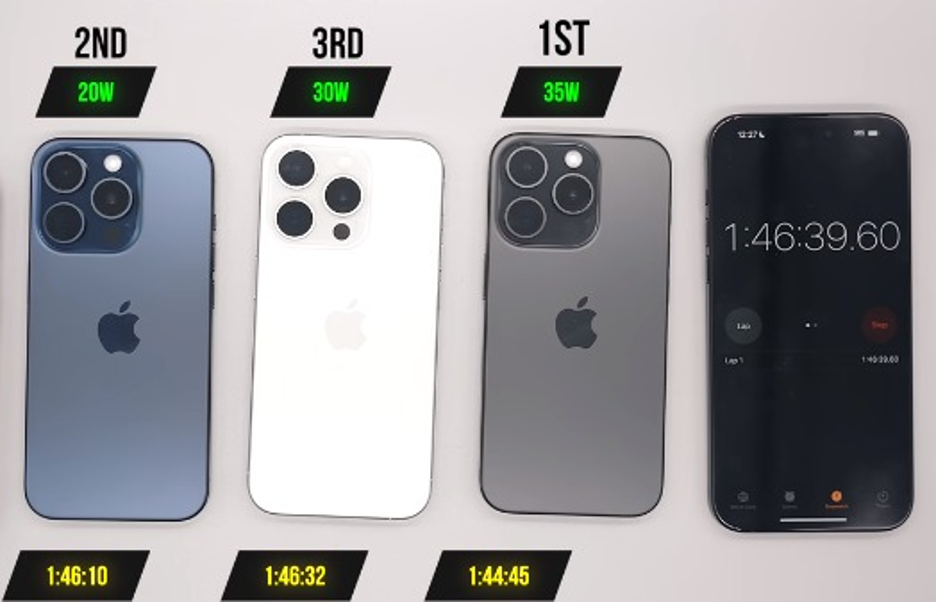iPhone 15 USB-C port: It’s Not That Impressive
December 04, 2023 6 min read 1 Comment
The USB-C Port in the iPhone 15 marks both progress and paradox. The slim port hosts USB 2.0 and USB 3.2 Gen 2 versions. They seem like past fossils (discussed shortly) compared to USB’s latest version, USB4 V2.
However, introducing USB-C in the iPhone is a game changer. Apple took 12 years to part ways with lightning ports.
This read zooms in on the exciting features of the iPhone 15 with its USB-C port, shedding light on how USB-C excitement has concealed the USB versions (old) it supports.
You will also know how long it takes to full tummy of your iPhone with different wattage capacities. Be prepared for some disappointment as you learn about the charging performance.
But the titanium-built iPhone is still there to make your life easier, especially for content creators. They can now record films directly to an external USB-C-compatible device.

Source: Apple
iPhone 15 USB-C Port: Knowledge Crumbs Taken From Apple’s Official Declaration of Independence from Lightning
Imagine faster charging, hassle-free data sharing, and endless possibilities connecting to all your favorite accessories and screens. iPhone 15 can do the following wonders with USB-C:
- Juice your iPhone 15 with a USB-C cable and compatible adapters, including faster charging with 20W or higher options.
- Quickly transfer data between your iPhone 15 and Mac, iPad, or other devices using USB-C cables.
- Thanks to USB Power Delivery support, use your iPhone 15 to charge AirPods, Apple Watch, and more.
- Listen with wired headphones or use audio accessories via the USB-C connector with adapters.
- Connect your iPhone 15 to external displays, monitors, and TVs, even supporting 4K resolution.
- Hook up your iPhone 15 to HDMI displays and TVs with 4K video output, including HDR content.
- Link your iPhone 15 to devices like CarPlay cars, external storage, and more.
Note: Ensure you have the right adapters or cables for different devices, such as USB-C or USB-C to USB-A or Type-A.
On the face of it, all seems perfect.
After all, what else could be better than carrying a single USB-C cable and charger for all your tech needs?
But, sadly, all is not GOOD with the iPhone 15 USB-C port.
Are you interested to know?
Hold onto your seats; we are going deeper.
iPhone 15 and 15 Plus USB-C Port Host USB 2.0
As the consumers are happy to receive their new iPhone 15 with a USB-C port, the tech geeks worry about the primitive USB 2.0 that Apple installed.
Version?... Port?....
Uni, what are you talking about?
Isn't it great to have USB-C in iPhone 15?
Well, USB-C is a port. The actual power lies in the version it carries to support high data transfer. To be crystal clear, take the following illustration.
Imagine there are different kinds of homes. Some are basic, like a simple shelter to protect you from the weather. In contrast, others are fancier, with all the amenities you need for a comfortable life.
In this comparison, the USB-C (the place) is just the shelter, and what makes it unique is the version or type of USB-C, which determines how comfortable and capable it is for your digital needs. So, it's not just about having a place; it's about the quality and features that the home offers.
The point of telling you the above illustration is that USB-2.0, installed in iPhone 15 and 15 Plus, is primitive compared to the latest USB4 V2. The following table shows the USB versions in order. Gaze your eyeballs on it.

The table clearly shows that in the fast-moving year of 2023, the iPhone 15 and 15 Plus remain stuck in a decades-old data transfer limit of 480 Mbps with USB version 2.0.
But that’s not the case with Pro and Pro Max models.
USB-C Port on iPhone 15 Pro and Pro Max Supports USB 3.2
When you use a USB 3 cable with the iPhone 15 Pro and Pro Max, you unlock their ability to achieve fast USB 3.2 Gen 2 speeds, up to 10Gbps. This means you can transmit data, including photos and videos, significantly faster than a USB 2 cable. It's like giving your data a high-speed express lane, making the transfer to your Mac or other computers much quicker and more efficient.
These top-of-the-line iPhones feature a camera with 5X optical zoom and a 48 MP main sensor and record 4k content, making them ideal for videography. High-resolution image and video capturing mean tons and tons of heavy data to be captured, stored, and transferred from iPhone to external device.
Therefore, Handling mountainous data needs data transfer speed in Gbps, not in Mbps. So, as opposed to the iPhone 15 and 15 Plus, which have USB 2.0 (480 Mbps), the Pro and Pro Max models have USB 3.2, which can carry a max of 10 Gbps.
USB 3.2 offers more than a mere data transfer speed. It’s also compatible with Thunderbolt 3, an industry standard for high-speed connections that allows docks, external screens, and storage devices, and is also compatible with USB 3.2.
In short, USB-C offers a lot for Pro and Pro Max, but for iPhone 15 and 15 Plus, USB-C is a gambit.
While there's been a lot of talk about data transfer and USB versions, one significant aspect hasn't received much attention: charging. Let's explore this essential element straightforwardly.
Does the iPhone 15 USB-C Port Charge Faster?
Surprisingly, there is no improvement in wired charging for any of the iPhone 15 models, including the Pro models, which feature faster USB 3 data transfer speeds. While these new iPhones have seen advancements in various aspects, such as data transfer, their charging speeds remain identical to their predecessors. This decision to keep charging speeds static may raise questions among users hoping for an upgrade in the latest iPhone models.
So, how long does USB-C take to charge iPhone 15?
We did some research on it.
The findings were shocking.
Take a look at the image taken from simplypop, a YouTube channel.

Charging three iPhones with 20, 30, and 35-watt power supplies using Apple-manufactured chargers produced surprising results.
All the phones took approximately 1 hour and 46 minutes on average to charge from 0% to 100%. This contradicts the common belief that higher-wattage chargers should speed up charging.
What’s wrong?
It doesn’t matter if you use a 100-watt or 30-watt charger; the iPhone uses its brain to pull power. This behavior seems consistent among different models. The following Image is the crux of our findings to make you aware of the charging time of Pro and Pro Max models.

As the image illustrates, at the 15-minute mark, the Pro's battery is cruising along at 30%, drawing 20 watts of power, while the Pro Max, with its larger capacity, is slightly behind at 29% but drawing a more robust 27 watts.
As we hit the half-hour mark, the Pro pushes ahead to 58% with a 16W draw, while the Pro Max is at 52%, sipping 19 watts. Approaching the 45-minute point, the Pro proudly boasts a 77% charge at a gentle 10W, whereas the Pro Max is at 72%, still comfortable but drawing 15W.
As the clock ticks to the 1-hour mark, the Pro is at 87%, drawing just 6 watts, while the Pro Max is at 83%, pulling a modest 8 watts. In a picturesque 1 hour and 29 minutes, the Pro reaches a full charge at 100%, signaling the mission accomplished. Meanwhile, the Pro Max is still in the process of charging. Finally, at 1 hour and 34 minutes, the Pro Max joins the Pro at the 100% charged celebration.
It's important to know that charging your battery is fastest when it's between 0% and 50%. After that, the speed slows down to help your battery last longer.
The switch from Apple's Lightning to USB-C in the iPhone 15 is a big deal with both good and not-so-good aspects. On the plus side, it aligns with the idea of having asingle cable for everything, making our tech lives easier. But how did this change come about?
Three Reasons Apple Divorcing Lightening Port
1 - E-waste Regulation:
EU laws pushed for a universal USB-C standard in smartphones by 2024, forcing Apple to adhere to a global commitment to reduce electronic waste.
2 - Ease User’s Life:
Apple's shift to USB-C ensures a seamless charging experience across all their devices, making life easier for customers by simplifying cable compatibility.
3 - Technical progress:
USB-C's faster data transfers and support for external storage devices mean quicker, more efficient tech interactions and shorter charging times for iPhone 15 models, all aimed at enhancing your digital life.
iPhone 15 USB-C Port: Final Words From Uni
The iPhone 15's new USB-C port is a mixed bag. It brings faster data transfer and convenience, but it doesn't charge your phone any faster. Apple made this switch because of rules to reduce electronic waste and to simplify things for users. Simply put, it's a step forward, but there's room for improvement.
Related Stories
1 Response
Leave a comment
Comments will be approved before showing up.
Also in Blog
How to Distinguish Low-Quality Electronic Waste on E-Commerce Platforms in 2025
March 19, 2025 3 min read
With the rise of online shopping, distinguishing between high-quality electronics and low-quality e-waste has become a critical skill. Many e-commerce platforms are flooded with questionable products that look appealing but often have serious quality and longevity issues.

Maximizing Your Internet Speed: The Ultimate Guide to Using a USB-C to Ethernet Adapter
July 12, 2024 4 min read
Read More Related Products
Recent Articles
- How to Distinguish Low-Quality Electronic Waste on E-Commerce Platforms in 2025 March 19, 2025
- Maximizing Your Internet Speed: The Ultimate Guide to Using a USB-C to Ethernet Adapter July 12, 2024
- How to Identify if a Device Supports UHS-II or UHS-I Protocols? June 24, 2024
- How to Use a USB-C Hub? Everything You Need to Know May 28, 2024
- Do I need a type c hub? What do you need to know before buying? April 12, 2024
- Can I Get 4k With USB-C to HDMI Cable or Hub? January 15, 2024
- Which USB-C Hub Should You Get? (Checklist) January 08, 2024
- Does USB-C Over Ethernet Work To Get Speedier Internet? January 01, 2024
- DisplayPort Over USB Type-C: The DP Alt Mode in Working December 27, 2023
- How to make Android phone Charge Faster (technician advice) December 11, 2023



Debra
June 04, 2025
I’m not super computer savvy. I have a uni card reader usb 3.0/usb-c and want to read a 64GB micro SD chip. Can I do that with an iPhone????